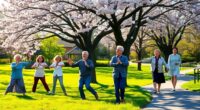Wellness trends transforming elderly care focus on holistic approaches that prioritize physical, mental, and emotional well-being. You'll find technological innovations like AI-driven health monitoring and telehealth improving access to care. Lifelong learning fosters cognitive health while social engagement creates a sense of community. Personalized wellness plans, tailored nutrition, and fitness routines enhance quality of life, while sustainability in facilities reduces environmental impact. Explore how these trends can enrich the experience of aging well for you or your loved ones.
Key Takeaways
- Holistic wellness approaches prioritize comprehensive care, addressing physical, mental, emotional, social, and spiritual needs of older adults for improved quality of life.
- Technological innovations, including AI health monitoring and telehealth, enhance access to care and enable proactive health management for seniors.
- Lifelong learning opportunities promote cognitive health and empower seniors, reducing cognitive decline and enhancing self-esteem through educational engagement.
- Social engagement initiatives within communities combat loneliness, fostering connections and promoting mental well-being through activities and volunteer opportunities.
- Sustainable practices in care facilities, such as eco-friendly building materials and farm-to-table dining, support health and environmental well-being for residents.
Holistic Wellness Approaches for Comprehensive Care
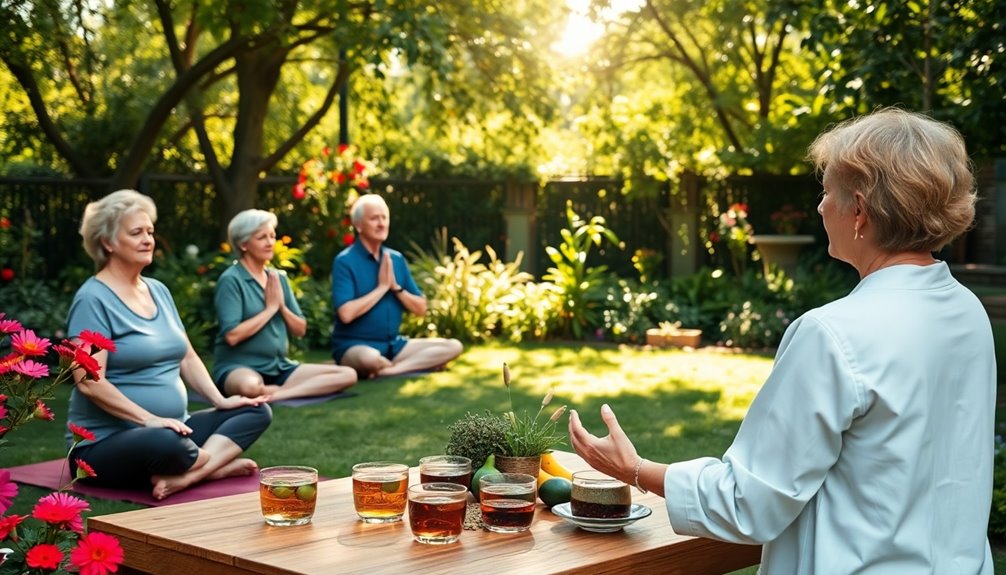
Holistic wellness approaches in elderly care prioritize the whole person, ensuring that physical, mental, emotional, social, and spiritual needs are met. You'll find that physical care focuses on daily activities and medical support, while mental care emphasizes cognitive stimulation to slow disease progression. Additionally, holistic care addresses not just physical health but also mental, emotional, social, and spiritual aspects. Emotional wellness thrives in nurturing environments, where empathetic support is key, and financial considerations for care can alleviate stress and enhance overall well-being. Social care encourages connections to combat loneliness, and spiritual care respects your individual beliefs and practices. These comprehensive strategies not only address immediate health concerns but also enhance overall quality of life.
Embracing Technological Innovations in Health Management

As you embrace holistic wellness approaches, integrating technological innovations into health management can further enhance care for the elderly. AI-driven health monitoring allows you to detect early warning signs, enabling proactive intervention and personalized care. By utilizing predictive risk stratification, you can ensure timely attention for seniors at higher risk, ultimately reducing hospital readmissions. With an estimated 82 million Americans over 65 by 2050, the demand for personalized care solutions will only continue to rise. Telehealth and virtual consultations offer convenient access to healthcare, breaking geographical barriers and improving communication with providers. Additionally, maintaining air quality in the living environment is crucial for the health of seniors, as it can significantly affect their well-being. Wearable health technology tracks vital signs and activity levels, empowering seniors to maintain their independence while ensuring their safety. Finally, smart home technologies enhance comfort and security, allowing seniors to control their environment. Together, these innovations create a supportive and responsive health management system for the elderly.
The Importance of Education and Lifelong Learning
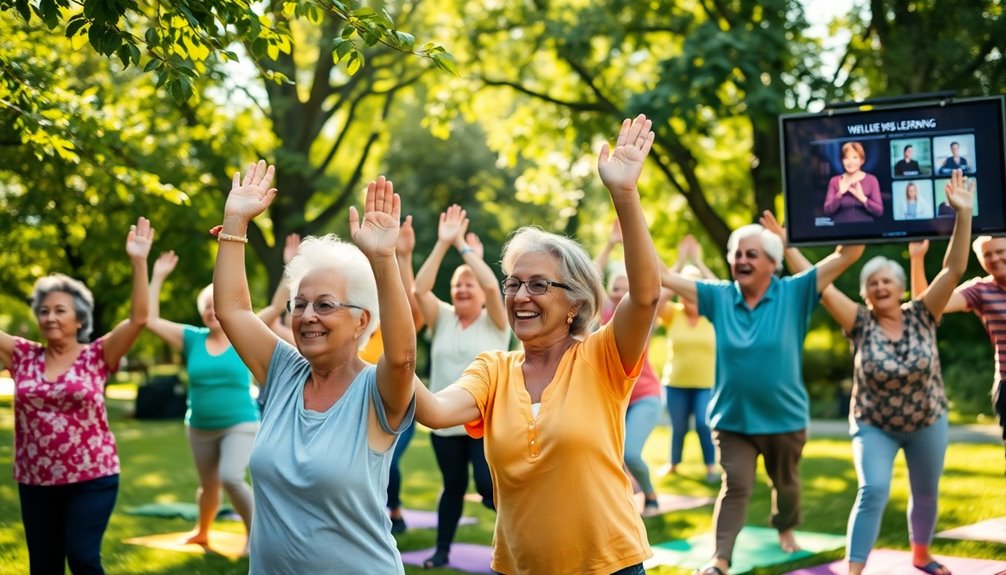
Education plays a crucial role in enhancing the quality of life for seniors, as it not only fosters cognitive health but also empowers them to navigate the complexities of aging. Engaging in lifelong learning stimulates brain cell growth, which helps reduce cognitive decline. With higher education levels, you're more likely to manage chronic conditions effectively and make informed health decisions. Many senior living communities offer programs that boost mental and emotional well-being, often in partnership with educational institutions. In fact, a study found that high educational attainment is linked to lower prevalence of functional disability and chronic diseases in the elderly. States like Texas and Florida even provide discounted tuition for seniors at colleges. By participating in these educational opportunities, you can combat depression and enhance self-esteem, all while building a supportive community that encourages healthy aging.
Fostering Social Engagement and Community Connections
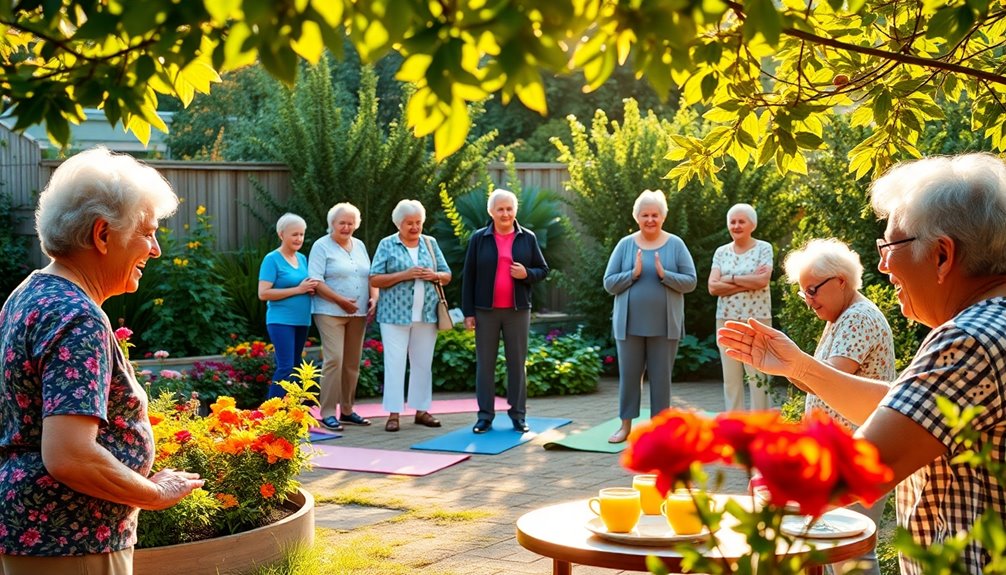
Social engagement plays a vital role in enhancing your overall well-being as you age, offering opportunities to connect with others and foster a sense of belonging. Participating in community activities not only boosts your psychological health but also gives you a renewed sense of purpose. Volunteering can be particularly rewarding, promoting social harmony while benefiting your health. Social engagement may buffer wellbeing declines in late life, highlighting its critical importance as you navigate the aging process. Despite cultural differences, policies supporting active aging recognize social engagement as essential for healthy living. Senior living communities are adapting by providing social activities that encourage participation, including spiritual retreats that offer opportunities for connection and reflection. However, barriers like accessibility and financial constraints can limit your engagement. Targeted programs for vulnerable groups and peer support models can help overcome these challenges, ensuring everyone has the chance to connect and thrive.
Creating Personalized Wellness Plans for Individual Needs

Building strong social connections can significantly enhance your well-being, but to truly thrive, personalized wellness plans are key. These plans begin with comprehensive assessments that evaluate your medical history and current health conditions. By considering your functional abilities and specific challenges, care teams tailor interventions and support to meet your individual needs. Conversations with you, your family, and healthcare providers ensure everyone is on the same page. Your care plan might include customized dining options, tailored therapy sessions, and lifestyle modifications based on your circumstances. A comprehensive assessment of physical, mental, and emotional well-being is fundamental to identifying your specific needs. Additionally, incorporating pet therapy into your wellness plan can enhance emotional well-being and reduce feelings of isolation. Ongoing monitoring allows for adjustments over time, keeping your wellness plan effective. Emphasizing your unique preferences and requirements, these plans create a pathway for a balanced and fulfilling life.
Promoting Mental Health and Emotional Well-Being
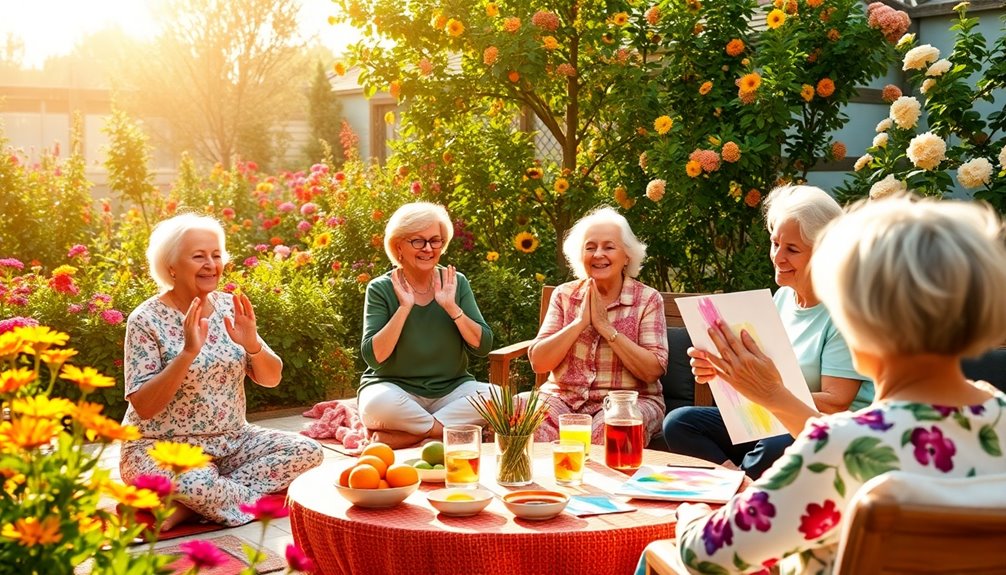
Although mental health issues can affect anyone, it's crucial to recognize that they aren't a normal part of aging. About one in five adults over 50 experience a mental health condition, and the pandemic significantly increased anxiety and depression rates among older adults.
With projections showing 15 million seniors may have psychiatric disorders by 2030, addressing these concerns is vital. Unfortunately, up to 63% of older adults with mental health issues don't receive necessary services. Untreated mental disorders can lead to cognitive decline, substance abuse, and increased mortality.
Utilizing technology like mindfulness apps and telehealth can enhance access to support. Additionally, fostering social connections and encouraging cognitive activities can boost emotional well-being.
Prioritizing mental health awareness ensures older adults lead fulfilling lives, free from stigma and isolation.
Integrating Physical Fitness Into Daily Routines
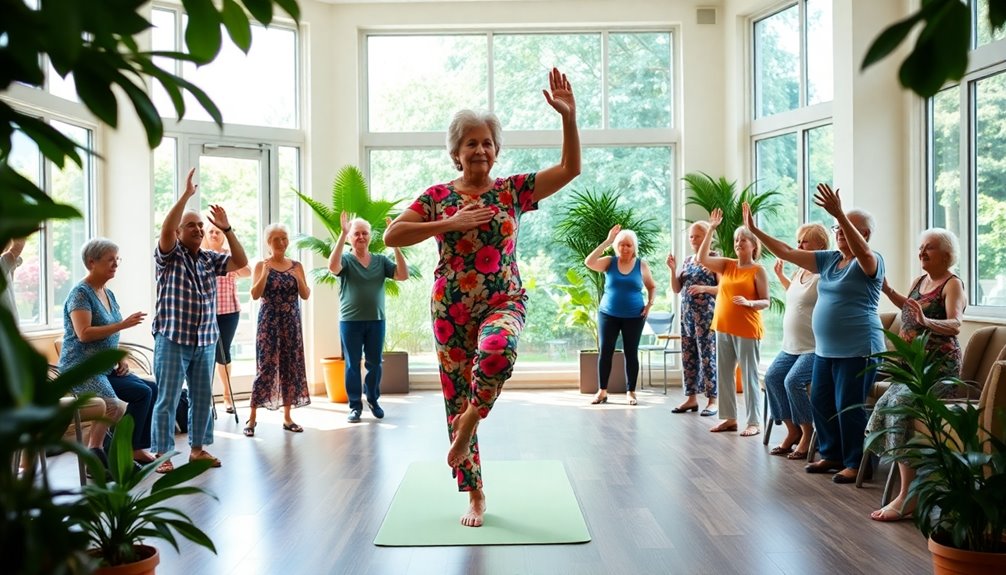
Mental well-being and physical fitness go hand in hand, especially for older adults looking to enhance their quality of life. You can integrate physical fitness into your daily routine by adopting simple, enjoyable activities. Start with light exercises, like walking or stretching, which you can do at home or in your community. Consider using wearable technology to track your progress and stay motivated, as fitness trackers provide real-time health data. Engaging in activities that include protein-rich options can also support muscle health and overall wellness. Joining a tailored fitness program can also foster social connections while improving strength and balance. Aim for a mix of aerobic and muscle-strengthening exercises to meet health guidelines.
Enhancing Nutritional Education and Meal Planning

As the importance of nutrition grows in elderly care, understanding how to enhance nutritional education and meal planning becomes essential for improving health outcomes.
You'll want to prioritize individualized nutrition plans designed by registered dietitian nutritionists. They can address unique health needs while ensuring older adults receive the right nutrients despite lower calorie requirements. Poor nutrition can lead to malnutrition, which underscores the necessity of tailored approaches to diet.
Educating caregivers about these nutritional needs is crucial for providing appropriate dietary care. Implementing personalized and therapeutic diets can effectively manage chronic conditions like diabetes and heart disease.
Additionally, consider utilizing technology for real-time nutrient tracking and meal delivery services, ensuring seniors get nutritious meals.
Supporting Spiritual Renewal and Mindfulness Practices
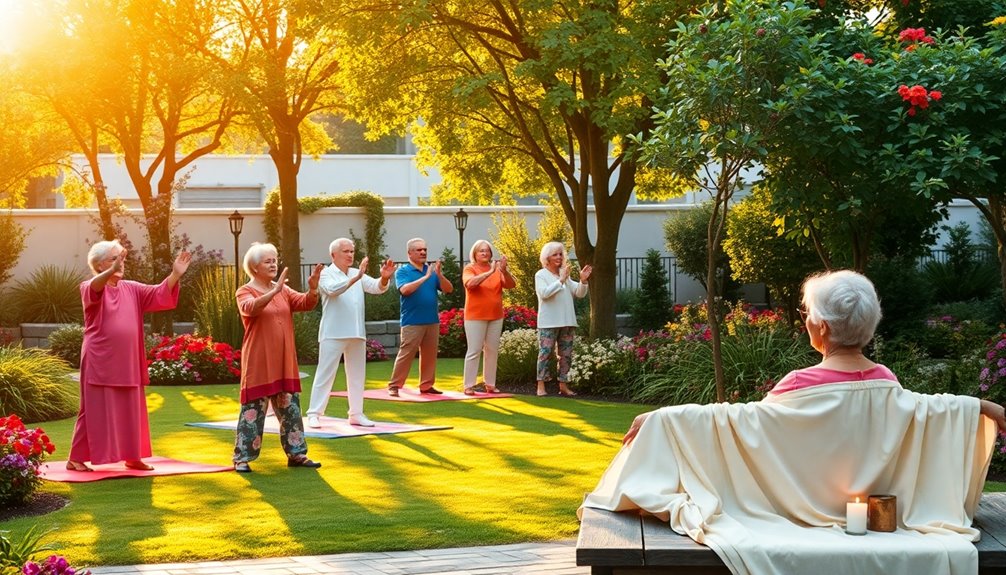
Supporting spiritual renewal and integrating mindfulness practices can significantly enhance the well-being of older adults. Spiritual comfort services reduce feelings of loneliness and improve mental health, while life review processes help you find purpose. Engaging in faith-based or non-faith-based interventions fosters a sense of community, alleviating isolation. Moreover, spirituality and religion can positively impact health, contributing to a holistic approach to well-being. Incorporating practices such as aromatherapy for relaxation can further support emotional balance and mental clarity. Mindfulness and meditation, increasingly embraced by seniors, help manage stress and emotions. By incorporating these practices into daily routines, you can experience benefits like reduced chronic pain and improved heart health. Senior living communities are recognizing this shift, offering holistic wellness approaches that combine yoga and tai chi. Together, these spiritual and mindfulness practices create a supportive environment, enhancing overall quality of life for older adults.
Prioritizing Sustainability and Eco-Friendliness in Care Facilities
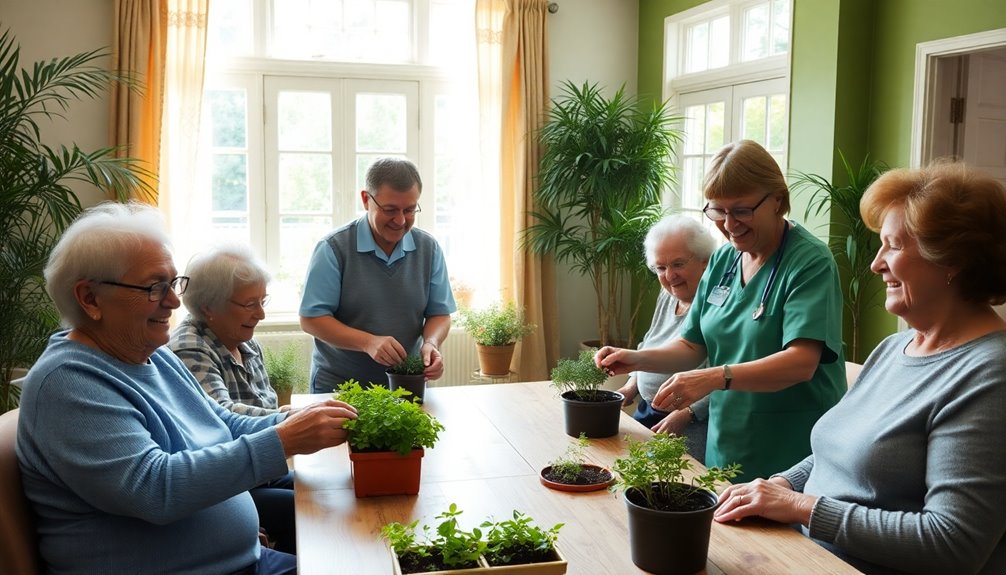
Prioritizing sustainability and eco-friendliness in care facilities not only benefits the environment but also enhances the quality of life for residents.
By shifting to renewable energy sources like solar panels, facilities lower energy costs and reduce fossil fuel reliance. Using eco-friendly building materials improves insulation while conserving resources. Implementing water conservation measures, such as rainwater harvesting, minimizes waste.
Creating green spaces promotes mental well-being and offers opportunities for outdoor activities. Incorporating farm-to-table dining with fresh produce fosters healthy eating. Data-powered facility upgrades ensure that these sustainable practices are continually optimized for efficiency and resident comfort.
These sustainable practices lead to cost savings and a reduced carbon footprint, making facilities more appealing to eco-conscious residents. Ultimately, embracing sustainability supports long-term viability while enhancing the overall living experience for everyone involved.
Frequently Asked Questions
How Can Families Get Involved in Wellness Programs for Seniors?
You can get involved in wellness programs for seniors by actively participating in their care plans.
Start by communicating regularly with caregivers to understand your loved one's needs. Attend wellness seminars together to learn about nutrition and fitness options.
Encourage frequent visits, which can boost their emotional well-being. Form support groups with other families to share experiences, and advocate for your senior's preferences to ensure they receive personalized, empathetic care.
What Are the Costs Associated With Personalized Wellness Plans?
Imagine painting a vibrant picture of care tailored just for you.
Personalized wellness plans can vary widely in cost. You'll find that higher care intensity, like skilled nursing, typically demands a steeper price. Geographic location plays a role too; urban centers often charge more.
Customized plans ensure you only pay for the services you need, enhancing your independence while keeping your financial future in mind. With careful planning, you can navigate these costs effectively.
Are There Any Specific Certifications for Wellness Professionals in Elderly Care?
Yes, there are specific certifications for wellness professionals in elderly care.
You can pursue the ACSA Certified Senior Health Coach (CSHC) for training in promoting healthy lifestyles among seniors.
The Foundation for Wellness Certificate and Leadership in Wellness Management Certificate offered by ICAA also enhance your skills in active-aging.
These certifications not only provide expert guidance but also ensure adherence to industry standards, helping you support seniors effectively in their wellness journeys.
How Can We Measure the Effectiveness of Wellness Programs for Seniors?
To measure the effectiveness of wellness programs for seniors, you should track participation rates and collect biometric data like blood pressure and BMI.
Regular evaluations help identify areas needing improvement.
Also, consider mental health assessments and healthcare utilization metrics to gauge overall impact.
Engaging participants through feedback mechanisms can provide insights into their experiences.
What Resources Are Available for Caregivers to Support Wellness Initiatives?
You've got plenty of resources to support your wellness initiatives as a caregiver.
The National Family Caregiver Support Program offers training and support groups. Area Agencies on Aging provide online workshops to help you manage care at home.
Respite care services give you a much-needed break, while adult day services offer social activities for seniors.
Don't forget about health education programs that focus on nutrition and disease management to enhance overall well-being.
Conclusion
Incorporating these wellness trends into elderly care isn't just about improving health; it's about enhancing lives. Did you know that older adults who engage socially are 50% more likely to enjoy a better quality of life? By embracing holistic approaches, technology, and personalized plans, you can foster a vibrant, fulfilling environment for seniors. Together, let's prioritize their well-being, ensuring they live not just longer, but happier, more connected lives in our communities.
References
- https://www.liveatwhitestone.org/news/current-wellness-trends-in-senior-living/
- https://www.whereyoulivematters.org/resources/wellness-trends-in-senior-living/
- https://bucknerretirement.org/blog/health-and-wellness-trends-for-seniors-in-2024/
- https://canohealth.com/news/blog/senior-wellness-trends/
- https://www.theplazaco.com/knowledge-center/trends-and-changes-in-senior-living-communities/
- https://www.senior-talk.com/blog/holistic-approaches-to-elderly-care
- https://www.medanta.org/patient-education-blog/holistic-approaches-to-elder-care-integrating-mind-body-and-spirit
- https://villagegreenretirement.com/top-senior-wellness-trends/
- https://friendshipcenters.org/holistic-health-approaches-for-elderly-care/
- https://healthcare.mindbowser.com/elderly-care-technology-in-home-health-care/

